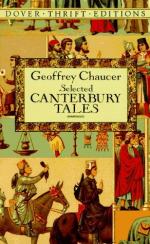|
|
The Canterbury Tales Notes & Analysis
The free The Canterbury Tales notes include comprehensive information and analysis to help you understand the book. These free notes consist of about 74 pages (22,108 words) and contain the following sections:
These free notes also contain Quotes and Themes & Topics on The Canterbury Tales by Geoffrey Chaucer.
The Canterbury Tales Plot Summary
The Canterbury Tales begins with the General Prologue, a detailed introduction and description of each of the pilgrims journeying to Canterbury to catch sight of the shrine to Sir Thomas a Becket, the martyred saint of Christianity, supposedly buried in the Cathedral of Canterbury since 1170. The pilgrims, a mixture of virtuous and villainous characters from Medieval England, include a Knight, his son the Squire, the Knight's Yeoman, a Prioress, a Second Nun, a Monk, a Friar, a Merchant, a Clerk, a Man of Law, a Franklin, a Weaver, a Dyer, a Carpenter, a Tapestry-Maker, a Haberdasher, a Cook, a Shipman, a Physician, a Parson, a Miller, a Manciple, a Reeve, a Summoner, a Pardoner, the Wife of Bath, and Chaucer himself. They each bring a slice of England to the trip with their stories of glory, chivalry, Christianity, villainy, disloyalty, cuckoldry, and honor. Some pilgrims are faithful to Christ and his teachings, while others openly disobey the church and its law of faithfulness, honor, and modesty.
The pilgrimage begins in April, a time of happiness and rebirth. They pilgrims hope not only to travel in this blessed time, but to have a rebirth of their own along the way. The pilgrimage consists of these characters journeying to Canterbury and back, each telling two tales in each direction, as suggested by the host. At the conclusion of the tales, the host will decide whose story is the best. The Knight is the first to tell a story, one made up properly of honor and chivalry. His tale is followed by the Miller's opposite tale of dishonor and frivolity. Chaucer frequently places tales of religion and Christ-like worship with tales of unfaithful women and cuckolded men. The Reeve, the Cook, and the Man of Law tell the next stories, while the host interjects his opinions throughout. There are several rivalries that grow from within the intertext, including the small quarrels between the Friar and Summoner and between the Miller and Reeve. Between each tale, most pilgrims have a prologue, in which they tell about themselves or allow Chaucer to illustrate the dynamics of the group. The Friar and the Summoner develop a minor feud, in which they each tell tales of ill-will towards the other's profession, and the Pardoner brings his own immoral behavior into the Tales. The Wife of Bath is a memorable character and is often thought of as a primordial feminist who acts on her own terms instead of those of the man.
The Canterbury Tales are not fully completed, for the original task of having each pilgrim tell two tales is never realized. Furthermore, two of the tales are begun and then suddenly cut off before their grand conclusion, such as the Squire's Tale and the Tale of Sir Thopas. Some of the pilgrims never even tell one story, such as the Tapestry-Maker and the Haberdasher, and the destination of Canterbury is not explicitly mentioned in the pilgrims' prologues or Chaucer's Retraction.
Chaucer concludes his tales with a Retraction, asking for mercy and forgiveness from those whom he may have offended along his course of storytelling and pilgrimage. He hopes to blame his ignorance and lack of education on any erroneous behavior or language, for he believes that his intentions were all moralistic and honorable. In the end, he gives all credit to Jesus Christ.




